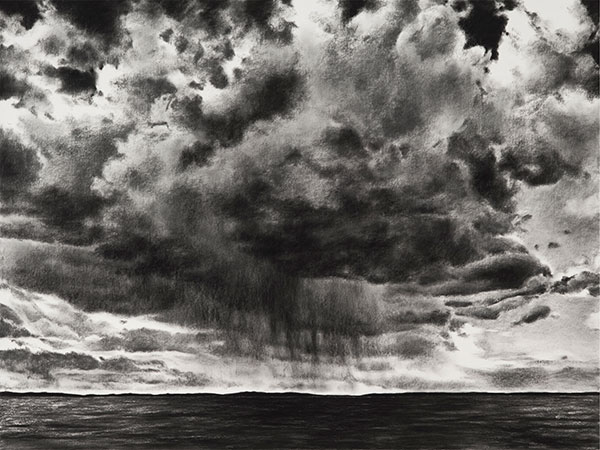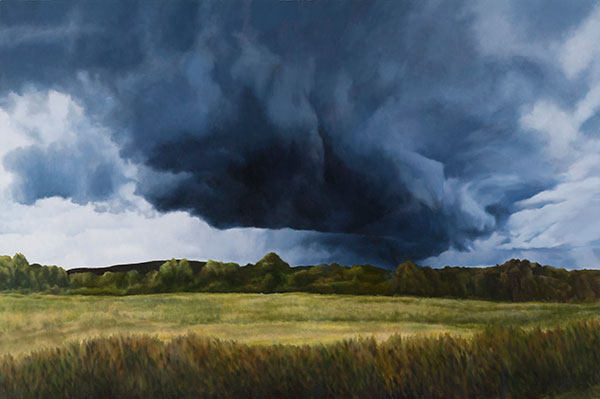

By THIRSTY

April Gornik
I am an artist that values, above all, the ability of art to move me emotionally and psychically. I make art that makes me question, that derives its power from being vulnerable to interpretation, that is intuitive, that is beautiful. – April Gornik
April Gornik has a most distinguished career as an artist and is best known for her landscape paintings. Her work is in the collections of the Museum of Modern Art, the Metropolitan Museum of Art, the Museum of Fine Arts Houston, the Smithsonian American Art Museum, the Whitney Museum of American Art and many significant private collections. She has been awarded the Lifetime Achievement in the Arts Award from Guild Hall Academy of the Arts and the Award of Excellence for Artistic Contributions to the Fight Against AIDS from amfAR. Born in Ohio, she lives on the eastern edge of Long Island with her husband and that is where Stay Thirsty Magazine visited with her for this discussion about the key concepts of her art and how she approaches her work as a painter.
STAY THIRSTY: High degree of abstraction.
APRIL GORNIK: This notion comes from a 30-year increasing realization of the strangeness of the process of making art, and less from the notion of "abstract" vs. "realistic," which of course my work essentially is. In making up an image, I typically use photographs, one or many, often collaged together to create a sketch that is then abstracted by the act of painting and drawing, which adds and eliminates details and alters "truth," whether it's photographic truth as we imagine photographs to represent (although of course they don't) or even scientific truth (what our eyes can actually see/take in within a certain perspective, light condition, etc.). For me composition is abstract behavior. Perhaps by abstraction I should more properly say alteration, but for me that always involves abstraction, and that embedded abstraction is what makes my work recognizably mine.

Storm Touching the Coast, 2015
STAY THIRSTY: Use of white on paper.
APRIL GORNIK: If you don't kill the white light that paper will give you when you're drawing, it becomes your greatest ally. Easier said, of course, but letting it through in the right way is one of the priceless gifts of drawing.
STAY THIRSTY: Creating an immersive experience from scale.
APRIL GORNIK: "We humans…" as Captain Kirk would say, have our own scale limitations, which means that we can anticipate an object of a certain size having a certain potential impact on us. So art has the ability to activate experience in us depending on how we stand in relation to it, literally. In big paintings particularly I like to feel them atmospherically and convey a real physical sense of what they represent, that's a process of paint, memory, and imagination.
STAY THIRSTY: Density and weight rather than detail and actuality.

Cloud Bringing Night, 2015
APRIL GORNIK: Detail and actuality end up being at the service of qualities that allow a painting to be muscular (or evaporative, e.g.) and "felt," rather than providing a descriptive experience to a viewer, which I associate more with actual detail. So leaves and clouds might be manipulated to give them more or less weight or density than they have in real life, to give a painting more tension, or dynamism, or congestion, or freedom. Such manipulation can have all sorts of different effects, and be very subtle, but can undermine what we actually see looking at a real scene to help it be a more contemplative, rather than a descriptive, object.
STAY THIRSTY: Light as the protagonist.
APRIL GORNIK: Renato Danese coined "light as protagonist" in describing my work since it's always the real "mover" in it, the thing that makes it alive. It's the sine qua non of art for me, for sure, a two-dimensional surface that contains actual light.
STAY THIRSTY: Paintings as metaphors for emotional states.
APRIL GORNIK: It's like the weather and the way it makes you feel, but more complicated. The idea of building emotion into the work is most interesting when it's not too simple. That said, the idea of making a painting or drawing that just expresses joy, and nothing else, is and should be a goal.

Marsh and Rising Clouds, 2015
STAY THIRSTY: Communicate time, information and emotional experience of the artist.
APRIL GORNIK: There's really nothing like handmade art for doing this. What other medium holds all of that in front of you at once? Music and literature move through time, and do it beautifully and in their own way. But the crazy way that art ends up containing the time taken, the information sifted through, rejected, accepted, and altered within the making of a single work of art, and the obvious and often complicated emotion that's contained in painting, not just in the way brushwork can be "angry" or colors can be "emotional," but in the way that an artists' whole working experience gets embedded in a work of art, is unique in human experience, whether direct or repressed or unconscious. You can see it in works of art both good and bad and it's a unique power art conveys.
Link:




